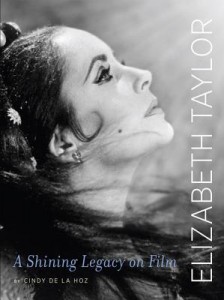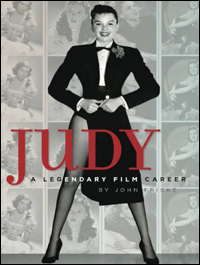 Elizabeth Taylor: A Shining Legacy on Film
Elizabeth Taylor: A Shining Legacy on Film
by Cindy De La Hoz
Running Press. 304 pages, $30.
 Judy: A Legendary Film Career
Judy: A Legendary Film Career
by John Fricke
Running Press. 352 pages, $30.
THE FABULOUS WORLDS of Elizabeth Taylor and Judy Garland are newly revisited in a pair of coffee table cum reference books published by Running Press. Before going into the particulars of each—Elizabeth Taylor: A Shining Legacy on Film, by Cindy De La Hoz, and Judy: A Legendary Film Career, by John Fricke—let me confess that I’m a passionate movie-goer and a fan of both of the actresses under review. I vividly remember falling in love with Elizabeth Taylor’s dark beauty and being spellbound by her violet eyes in National Velvet (1944), and being enchanted by Judy in The Wizard of Oz (1939) singing “Somewhere Over the Rainbow” as no one else ever has or could.
Elizabeth Taylor fans know she was “bad” in the most subversive sense of the word. She was a bad girl on stage and off. In a 1992 essay for Penthouse, Camille Paglia called her a “pre-feminist woman and a femme fatale.” In contrast, De La Hoz reconfigures Taylor as a thoroughgoing feminist in her defiance of male power and in many of the parts she played (echoing M. G. Lord’s thesis in 2012’s biography The Accidental Feminist). Despite seeming poles apart, both Paglia and De La Hoz agree that there is something elemental about Taylor as a woman and film star.
Both are right to affirm that Taylor’s importance as an actress partially rests on the fact that she represented a kind of womanliness that is now completely impossible to find onscreen in the U.S. or the U.K. It was a sexiness rooted in hormonal reality: she was a force of nature, and the camera loved her for it. In the 1950s, she burned up the screen in two of Tennessee Williams’ most memorable plays, Cat on a Hot Tin Roof (1958) and Suddenly Last Summer (1959). Her star power as Maggie the cat is an enduring rebuke to postmodernism and post-structuralism, which maintain that gender is merely a social construct. Her portrayal of call girl Gloria Wandrous in Butterfield 8 (1960) won her an Oscar for Best Actress, but most critics agreed that she should have gotten it for her performance as Maggie.
Taylor was rarely given her due as an actor during her career, but she always saw herself as a serious actress: “The emotion has got to be there behind your eyes, behind your heart. You can never act superficially and get away with it.” Certainly her Oscar-winning performance in Who’s Afraid of Virginia Woolf? (1967) lay to rest any lingering doubts about her talent. In the same year, she made the underrated film Reflections in a Golden Eye, based on a Carson McCullers novel, which included a smoldering homosexual subplot. This is one of her most interesting and experimental interpretations, and critics called her performance superb.
Taylor brought the same passion to her life off the screen. One of her most volatile relationships was with Richard Burton. The couple exploded off the pages of the tabloids during the 1960s. She was so deeply in love with him that she married him twice. Burton, who was no slouch as a stage actor, declared that he learned everything he knew about making movies from Elizabeth.
The excitement of De La Hoz’ book lies not only in the sheer number of excellent photographs of Liz in a single volume but also in the fact that the author has assembled so many examples that highlight the recurring themes that are common to so many of Taylor’s films. The book covers Dame Elizabeth’s career from her earliest performances as a child star to the end, including her business enterprises in branded jewelry and perfumes, and her charitable work as an AIDS activist. To say that Taylor had staying power is no understatement. She’s one of the few stars who started as a child and continued film acting through most of her life.
Elizabeth Taylor is a nostalgic and even a somewhat sentimental excursion into a bygone age. Its major strength as a reference is that it covers all of her movies and even her television roles, right down to her cameos in The Flintstones and These Old Broads.
As bad as Elizabeth Taylor was is approximately equal to how good Judy Garland was, at least in the sense of trying to please other people. In 352 chronologically ordered pages, longtime Garland biographer and fan John Fricke celebrates the 75th anniversary of Judy Garland’s screen debut in the 1936 film Pigskin Parade. Using materials from the author’s own collection, Fricke features hundreds of never-before-seen photographs of Garland on the sets of her films.
As the proud owner of a vintage still photograph of Judy in A Star is Born (1954), I can attest to the stunning opulence of Fricke’s Judy as a reference book. I was knocked out by the quality of the illustrations. (I had the honor of meeting Miss Garland once in 1969 at a friend’s house in Coconut Grove, Florida, when she was married to Mickey Deans.) Fricke begins with a concise introduction and fact-filled, unsentimental biography of his subject. A well-respected Garland expert, Fricke has gone to great pains to select artwork, reviews, and personal quotations that haven’t been emphasized in the numerous (around sixty) books published on Garland to date. Even so, given Garland’s long and distinguished career as an entertainer, some repetition was unavoidable.
In interviews, Fricke disclosed that this is his most candid book: “It’s the first time I’ve been able to be as honest as I wanted to be. All the people are dead now!” Indeed it is a pull-no-punches analysis that paints a picture of Judy as the highly talented, amazingly versatile, and terribly vulnerable woman whose poor judgment in men led to no end of troubles throughout her life. (It’s not a pretty picture, and I saw it up close up and personal when I met her. She was a charismatic wreck.)
As a child star, her mother hand fed her addictive pills—pills to get up, pills to keep going, and pills to get to sleep. The MGM studio worked her into a nervous breakdown with a combination of drugs, dieting, and a killer schedule of personal appearances and photo shoots. She was a box office hit and a top money machine, and they were merciless in exploiting her talents. Garland’s output was, in fact, astonishing. Despite numerous breakdowns, from which she bounced back by a sheer act of will, she made inroads not only in film but also on the radio and television, not to mention her concert performances, which were second to none. She filled the house night after night. In the end she was one of the most talented, most exploited, and most savagely victimized stars in history of the movies.
Unlike Taylor, who had a will of iron and forced the studio to give her whatever she wanted, Garland went through the mental and emotional tortures of the damned. This vulnerability probably explains her incomparable performances in A Star is Born (1954), Judgment at Nuremberg (1961), A Child Is Waiting (1963), and I Could Go On Singing (1963). Based on her stellar performances in every one of these films, we can only guess at the mental and emotional conflicts she wrestled with during the making of these movies. But whatever personal or professional craziness was happening off-screen, Garland always rose to the occasion, often going above and beyond what directors expected. Veteran actress Elaine Stritch discloses that she has watched Judy’s films for professional and personal inspiration: “Never have I caught her in a lie. And never have I caught her ‘acting.’”
Such career highlights as The Wizard of Oz, Easter Parade (1948), and A Star Is Born are deservedly celebrated, but I also urge fans to take another look at For Me and My Gal (1942) and In the Good Old Summertime (1949), in which Garland delivers wonderful performances. Her last film, I Could Go on Singing (1963), remains as under-appreciated as Meet Me in St. Louis (1944) is overrated. I Could Go on Singing, with all of its semi-autobiographical overtones, would make an excellent double feature with A Star Is Born. In the former movie, Garland elevates what Fricke calls “a soap opera with songs” to levels of brilliance that today’s performers would be hard-pressed to match. She put her heart and soul into her portrayals, always revealing basic truths about how complicated the human condition truly is.
Lengthy sections of his book are also devoted to films that Garland started to work on but didn’t complete. The book contains about 550 photographs, about half from Fricke’s personal collection. “I must have about 6,000 here,” he said from his home in New York City. “It’s not so much collecting as it is accumulating.” Garland fans hold Fricke’s work in high esteem. Those who’ve enjoyed his other efforts—co-authoring The Wizard of Oz: The Official 50th Anniversary Pictorial History; co-producing PBS’s Judy Garland: By Myself, for which he won an Emmy in 2004; and providing audio commentary on Garland DVDs, including For Me and My Gal (1942 ) and Easter Parade (1948)—will find this one more jewel added to his diva’s crown.
Cassandra Langer is a freelance writer based in New York City.





